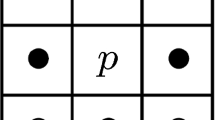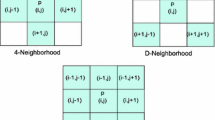Abstract
This paper proposes a parallel image thinning algorithm and a skeletonization algorithm based on cellular automaton (CA). Cellular automaton is a parallel computation model and a non-linear dynamical system. In this paper, each image pixel is identified as a cell of CA and the change of cell depends on the current state of itself and the state of its neighbors. In a binary image, this paper assumes that the objects (white pixel) are preys which are surrounded by many ants (every black pixels). The movement of ants is controlled by cellular automation. The ants gnaw preys until the preys (objects) become skeleton. The proposed parallel skeletonization algorithm can produce a traditional skeleton with a thin line located in the center of object, and the proposed thinning algorithm can produce a new kind of skeleton which is named as the ants-gnawing skeleton. The computation of ants-gnawing skeleton is faster than the traditional skeleton while it contains more the structural features of image. Benefiting from the properties of cellular automation, the proposed thinning algorithm does not change the basic geometry structure of image, and it is invariant for image rotation.












Similar content being viewed by others
References
Aslan C, Erdem A, Erdem E, Tari S (2008) Disconnected skeleton: shape at its absolute scale. IEEE Trans Pattern Anal Mach Intell 30(12):2188–2203
Aurenhammer F (1991) Voronoi diagramsa survey of a fundamental geometric data structure. Acm Computing Surveys 23(3):345–405
Bai X, Latecki LJ, Liu WY (2007) Skeleton pruning by contour partitioning with discrete curve evolution. IEEE Trans Pattern Anal Mach Intell 29 (3):449–62
Bidlo M (2016) On routine evolution of complex cellular automata. IEEE Trans Evol Comput 20(5):742–757
Blum H, Nagel RN (1978) Shape description using weighted symmetric axis features. Pattern Recogn 10(3):167–180
Bouaynaya N, Charif-Chefchaouni M, Schonfeld D (2006) Spatially variant morphological restoration and skeleton representation. IEEE Trans Image Process 15(11):3579–3591
Brandt JW, Algazi VR (1992) Continuous skeleton computation by voronoi diagram<î. Cvgip Image Understanding 55(3):329–338
By O (2010) Hierarchic voronoi skeletons. Pattern Recogn 28 (3):343–359
Chang HH, Yan H (1996) Skeletonization of binary digital patterns using a fast euclidean distance transformation. Opt Eng 35(3):1003–1008
Chen P, Lin CL, Chern IL (2013) A perfect match condition for point-set matching problems using the optimal mass transport approach. Siam J Imaging Sci 6(2):730–764
Choi WP, Lam KM, Siu WC (2003) Extraction of the euclidean skeleton based on a connectivity criterion. Pattern Recogn 36(3):721–729
Delgadofriedrichs O, Robins V, Sheppard A (2015) Skeletonization and partitioning of digital images using discrete morse theory. IEEE Trans Pattern Anal Mach Intell 37(3):654–666
Du H, Ma L, Li G, Wang S (2020) Low-rank graph preserving discriminative dictionary learning for image recognition. Knowl-Based Syst 187:104823
Fang Z, Xiao Z, Lei G, Wu J, Xu Z, Wang D, Xi J (2015) Skeleton extraction based on anisotropic partial differential equation. Optik - Int J Light Elect Opt 126(23):3692–3697
Gonzalez RC, Woods RE, Eddins SL (2007) Digital image processing using MATLAB Pearson/Prentice Hall
Jin D, Iyer KS, Cheng C, Hoffman EA, Saha PK (2015) A robust and efficient curve skeletonization algorithm for tree-like objects using minimum cost paths. Pattern Recogn Lett 76:32–40
Kaur I, Mentrelli A, Bosseur F, Filippi JB, Pagnini G (2016) Turbulence and fire-spotting effects into wild-land fire simulators. Commun Nonlinear Sci Numer Simul 39:300–320
Lam L, Lee SW, Suen CY (1992) Thinning methodologies. IEEE Trans Pattern Anal Mach Intell 14(9):869–885
Latecki LJ, Lakamper R (1999) Convexity rule for shape decomposition based on discrete contour evolution. Comput Vision Image Understand 73(3):441–454
Leymarie F, Levine M (1992) Simulating the grassfire transform using an active contour model. IEEE Trans Pattern Anal Mach Intell 14(1):56–75
Nayak DR, Patra PK, Mahapatra A (2014) A survey on two dimensional cellular automata and its application in image processing. Comput Sci 66 (1):78–87
Pei L, Liu X, Min T, Xin L (2017) An extended target tracker based on structural appearance and improved distribution fields for different scenarios. Optik - Int J Light Elect Opt 143:26–34
Rosin PL (2006) Training cellular automata for image processing. IEEE Trans Image Process 15(7):2076–2087
Saha PK, Borgefors G, Baja GSD (2015) A survey on skeletonization algorithms and their applications. Pattern Recogn Lett 76:3–12
Shamir A, Shaham A (2006) Skeleton based solid representation with topology preservation. Graph Model 68(3):307–321
Shen W, Wang Y, Bai X, Wang H, Latecki LJ (2013) Shape clustering: common structure discovery. Pattern Recogn 46(2):539–550
Suarez AJF, Hubert E (2018) Scaffolding skeletons using spherical voronoi diagrams: feasibility, regularity and symmetry. Comput Aided Des 62:45–50
Tabedzki M, Saeed K, Szczepanski A (2016) A modified k3m thinning algorithm. Int J Appl Math Comput Sci 26(2):439–450
Tang C, Lu W, Cai Y, Han L, Wang G (2008) Nearly preprocessing-free method for skeletonization of gray-scale electronic speckle pattern interferometry fringe patterns via partial differential equations. Opt Lett 33(2):183–185
Tari ZS, Shah J, Pien H et al (1997) Extraction of shape skeletons from grayscale images[J]. Comput Vis Image Underst 66(2):133–146
Vasilevskiy A, Siddiqi K (2002) Flux maximizing geometric flows. IEEE Trans Pattern Anal Mach Intell 24(12):1565–1578
Wang S, Wu J, Wei M, Ma X (2012) Robust curve skeleton extraction for vascular structures. Graph Model 74(4):109–120
Wei R, Li X, Wang QH (2017) Double color image encryption scheme based on off-axis holography and maximum length cellular automata. Optik - Int J Light Elect Opt 145:407–417
Wei S, Xiang B, Yang XW, Latecki LJ (2013) Skeleton pruning as trade-off between skeleton simplicity and reconstruction error. Sci China Inform Sci 56(4):1–14
Wieser E, Seidl M, Zeppelzauer M (2017) A study on skeletonization of complex petroglyph shapes. Multimed Tools Appl 76(6):8285–8303
Wink O, Niessen WJ, Viergever MA (2004) Multiscale vessel tracking. IEEE Trans Med Imaging 23(1):130–133
Wong WT, Shih FY, Su TF (2006) Thinning algorithms based on quadtree and octree representations. Inf Sci 176(10):1379–1394
Xie W, Thompson RP, Perucchio R (2003) A topology-preserving parallel 3d thinning algorithm for extracting the curve skeleton. Pattern Recogn 36 (7):1529–1544
Yasseen Z, Verroust-Blondet A, Nasri A (2016) Shape matching by part alignment using extended chordal axis transform. Pattern Recogn 57 (2):115–135
Youssef R, Sevestre-Ghalila S, Ricordeau A, Benazza A (2016) Self noise and contrast controlled thinning of gray images. Pattern Recogn 57:97–114
Zhang TY, Suen CY (1984) Fast parallel algorithm for thinning digital patterns. Commun ACM 3(3):236–239
Zhu X, Jing XY, Ma F, Cheng L, Ren Y (2019) Simultaneous visual-appearance-level and spatial-temporal-level dictionary learning for video-based person re-identification. Neural Comput Appl 31(11):7303–7315
Acknowledgment
This research was supported by the National Key Technology Research and Development Program of China (Grant No. 2015BAK01B06) and the Natural Science Foundation of Henan Province (Grant No. 162300410032).
Author information
Authors and Affiliations
Corresponding authors
Additional information
Publisher’s note
Springer Nature remains neutral with regard to jurisdictional claims in published maps and institutional affiliations.
Rights and permissions
About this article
Cite this article
Zhang, F., Chen, X. & Zhang, X. Parallel thinning and skeletonization algorithm based on cellular automaton. Multimed Tools Appl 79, 33215–33232 (2020). https://doi.org/10.1007/s11042-020-09660-5
Received:
Revised:
Accepted:
Published:
Issue Date:
DOI: https://doi.org/10.1007/s11042-020-09660-5




